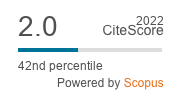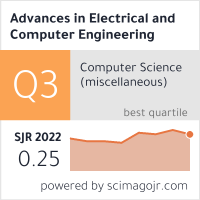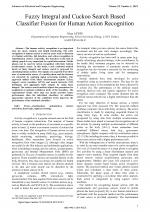| 1/2018 - 1 | View TOC | « Previous Article | Next Article » |
Fuzzy Integral and Cuckoo Search Based Classifier Fusion for Human Action RecognitionAYDIN, I. |
| View the paper record and citations in |
| Click to see author's profile in |
| Download PDF |
Author keywords
classification, optimization, feature extraction, fuzzy logic, signal processing
References keywords
recognition(13), activity(10), human(8), sensors(6), computing(6), fuzzy(4)
Blue keywords are present in both the references section and the paper title.
About this article
Date of Publication: 2018-02-28
Volume 18, Issue 1, Year 2018, On page(s): 3 - 10
ISSN: 1582-7445, e-ISSN: 1844-7600
Digital Object Identifier: 10.4316/AECE.2018.01001
Web of Science Accession Number: 000426449500001
SCOPUS ID: 85043298309
Abstract
The human activity recognition is an important issue for sports analysis and health monitoring. The early recognition of human actions is used in areas such as detection of criminal activities, fall detection, and action recognition in rehabilitation centers. Especially, the detection of the falls in elderly people is very important for rapid intervention. Mobile phones can be used for action recognition with their built-in accelerometer sensor. In this study, a new combined method based on fuzzy integral and cuckoo search is proposed for classifying human actions. The signals are acquired from three axes of acceleration sensor of a mobile phone and the features are extracted by applying signal processing methods. Our approach utilizes from linear discriminant analysis (LDA), support vector machines (SVM), and neural networks (NN) techniques and aggregates their outputs by using fuzzy integral. The cuckoo search method adjusts the parameters for assignment of optimal confidence levels of the classifiers. The experimental results show that our model provides better performance than the individual classifiers. In addition, appropriate selection of the confidence levels improves the performance of the combined classifiers. |
| References | | | Cited By «-- Click to see who has cited this paper |
| [1] M. Vrigkas, V. Karavasilis, C. Nikou, & I.A. Kakadiaris, "Matching mixtures of curves for human action recognition," Computer Vision and Image Understanding, vol. 119, pp. 27-40, Feb. 2014, [CrossRef] [Web of Science Times Cited 26] [2] J. Morales, D. Akopian, "Physical activity recognition by smartphones, a survey,". Biocybernetics and Biomedical Engineering, vol. 37, pp. 388-400, May 2017. [CrossRef] [Web of Science Times Cited 75] [3] L. Bao, S. Intille, "Activity recognition from user-annotated acceleration data," Pervasive computing, vol. 3001, pp. 1-17, Apr. 2004, [CrossRef] [Web of Science Times Cited 1795] [4] L. Chen, J. Hoey, C. D. Nugent, D.J. Cook, Z. Yu, "Sensor-based activity recognition," IEEE Transactions on Systems, Man, and Cybernetics, Part C, vol. 42, pp. 790-808, May 2012, [CrossRef] [Web of Science Times Cited 681] [5] J. R. Kwapisz, G. M. Weiss, S.A. Moore, "Activity recognition using cell phone accelerometers," ACM SigKDD Explorations Newsletter, vol. 12, pp. 74-82, Dec. 2011, [CrossRef] [6] G. Son, S. Kwon, Y. Lim, "Speech Rate Control for Improving Elderly Speech Recognition of Smart Devices," Advances in Electrical and Computer Engineering, vol.17, no.2, pp.79-84, May 2017, [CrossRef] [Full Text] [Web of Science Times Cited 4] [7] C. Catal, S. Tufekci, E. Pirmit, G. Kocabag, G. "On the use of ensemble of classifiers for accelerometer-based activity recognition," Applied Soft Computing, vol. 37, pp. 1018-1022, Dec. 2015, [CrossRef] [Web of Science Times Cited 156] [8] M. Field, D. Stirling, Z. Pan, M. Ros, F. Naghdy, "Recognizing human motions through mixture modeling of inertial data," Pattern Recognition, vol. 48, pp. 2394-2406, Aug. 2015, [CrossRef] [Web of Science Times Cited 39] [9] E. Vats, C. S. Chan, "Early detection of human actions-a hybrid approach," Applied Soft Computing, vol. 46, pp. 953-966, Sept. 2016, [CrossRef] [Web of Science Times Cited 12] [10] F. Attal, S. Mohammed, M. Dedabrishvili, F. Chamroukhi, L. Oukhellou, Y. Amirat, "Physical human activity recognition using wearable sensors," Sensors, vol. 15, 31314-31338, Dec. 2015, [CrossRef] [Web of Science Times Cited 478] [11] A. Mannini, A. M. Sabatini, "Machine learning methods for classifying human physical activity from on-body accelerometers," Sensors, vol. 10, pp. 1154-1175, Feb. 2010. [CrossRef] [Web of Science Times Cited 486] [12] O.-A. Schipor, S.-G. Pentiuc, M.-D. Schipor, "Toward automatic recognition of children's affective state using physiological parameters and fuzzy model of emotions," Advances in Electrical and Computer Engineering, vol.12, pp.47-50, May 2012, [CrossRef] [Full Text] [Web of Science Times Cited 8] [13] L. Gao, A. K. Bourke, J. Nelson, "Activity recognition using dynamic multiple sensor fusion in body sensor networks," In: Proc of IEEE Engineering in Medicine and Biology Society, San Diego, 2012, pp. 1077-1080, [CrossRef] [14] K. Cho, N. Iketani, H. Setoguchi, M. Hattori, M. "Human activity recognizer for mobile devices with multiple sensors," In: IEEE International Conference on Ubiquitous, Autonomic and Trusted Computing, 2009, pp. 114-119, [CrossRef] [15] A. Lopez-Mendez, J.R. Casas, "Model-based recognition of human actions by trajectory matching in phase spaces," Image and Vision Computing, vol. 30, pp. 808-816, Nov. 2012, [CrossRef] [Web of Science Times Cited 16] [16] A. Wang, G. Chen, J. Yang, S. Zhao, C.Y. Chang, "A comparative study on human activity recognition using inertial sensors in a smartphone," IEEE Sensors Journal, vol. 16, pp.4566-4578, March 2016, [CrossRef] [Web of Science Times Cited 195] [17] K. Barbe, R. Pintelon, J. Schoukens. "Welch method revisited: nonparametric power spectrum estimation via circular overlap," IEEE Transactions on signal processing, vol. 58, pp. 553-565, Feb. 2010, [CrossRef] [Web of Science Times Cited 90] [18] S.B. Cho, J.H. Kim, "Multiple network fusion using fuzzy logic," IEEE Transactions on Neural Networks, vol. 6, pp. 497-501, Mar 1995, [CrossRef] [Web of Science Times Cited 144] [19] S.L. Wu, Y.T. Liu, T. Y. Hsieh, Y.Y. Lin, C.Y. Chen, C.H. Chuang, C. T. Lin, "Fuzzy integral with particle swarm optimization for a motor-imagery-based braincomputer interface," IEEE Transactions on Fuzzy Systems, vol. 25, pp. 21-28, Aug 2016, [CrossRef] [Web of Science Times Cited 55] [20] J. Friedman, T. Hastie, R. Tibshirani, The elements of statistical learning, New York: Springer series in statistics, pp. 241-249, 2001. [21] V. V. Phansalkar, P. S. Sastry "Analysis of the back-propagation algorithm with momentum," IEEE Transactions on Neural Networks vol. 5, pp. 505-506, May 1994, [CrossRef] [Web of Science Times Cited 113] [22] N. Cristianini, B. Scholkopf, "Support vector machines and kernel methods: the new generation of learning machines," Ai Magazine, vol. 23, pp. 31-41, Fall 2002, [CrossRef] [23] R. Rajabioun, "Cuckoo optimization algorithm," Applied soft computing, vol. 11, pp. 5508-5518, Dec. 2011, [CrossRef] [Web of Science Times Cited 727] [24] A. H. Gandomi, X. S. Yang, A. H. Alavi, "Cuckoo search algorithm: a metaheuristic approach to solve structural optimization problems," Engineering with computers, vol.29, pp. 17-35, Jan. 2013, [CrossRef] [Web of Science Times Cited 1133] Web of Science® Citations for all references: 6,233 TCR SCOPUS® Citations for all references: 0 Web of Science® Average Citations per reference: 249 ACR SCOPUS® Average Citations per reference: 0 TCR = Total Citations for References / ACR = Average Citations per Reference We introduced in 2010 - for the first time in scientific publishing, the term "References Weight", as a quantitative indication of the quality ... Read more Citations for references updated on 2024-04-14 17:01 in 132 seconds. Note1: Web of Science® is a registered trademark of Clarivate Analytics. Note2: SCOPUS® is a registered trademark of Elsevier B.V. Disclaimer: All queries to the respective databases were made by using the DOI record of every reference (where available). Due to technical problems beyond our control, the information is not always accurate. Please use the CrossRef link to visit the respective publisher site. |
Faculty of Electrical Engineering and Computer Science
Stefan cel Mare University of Suceava, Romania
All rights reserved: Advances in Electrical and Computer Engineering is a registered trademark of the Stefan cel Mare University of Suceava. No part of this publication may be reproduced, stored in a retrieval system, photocopied, recorded or archived, without the written permission from the Editor. When authors submit their papers for publication, they agree that the copyright for their article be transferred to the Faculty of Electrical Engineering and Computer Science, Stefan cel Mare University of Suceava, Romania, if and only if the articles are accepted for publication. The copyright covers the exclusive rights to reproduce and distribute the article, including reprints and translations.
Permission for other use: The copyright owner's consent does not extend to copying for general distribution, for promotion, for creating new works, or for resale. Specific written permission must be obtained from the Editor for such copying. Direct linking to files hosted on this website is strictly prohibited.
Disclaimer: Whilst every effort is made by the publishers and editorial board to see that no inaccurate or misleading data, opinions or statements appear in this journal, they wish to make it clear that all information and opinions formulated in the articles, as well as linguistic accuracy, are the sole responsibility of the author.





